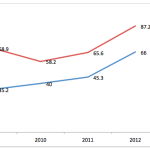As I sit down to type this post, I realize how busy we have been this year. The telltale sign for me is looking up at the calendar and realizing the first month of 2014 is in the rearview mirror! The Super Bowl is now in the history books (how about those commercials) and somehow I have missed my annual list of HIT predictions. Seems a bit a late for that now, so in lieu of HIT predictions I’ll simply summarize the challenges and opportunities we’ll inevitably face at the crossroads of health information technology and nephrology in 2014.
ICD-10
If I have said it once…well you know the rest. September 30, 2014, increasingly looks like a wonderful day to retire from the practice of nephrology, if you can do so. On the following day our world will change. Our old friends 585.x, 250.xx, and my personal favorite E845.0 will ride off into the sunset, replaced by the more detailed (and more complex) ICD-10 code set. The fact that the rest of the civilized world has been using ICD-10 for many years will provide little consolation to those of you who have memorized a number of ICD-9 codes. Adding insult to injury, every payer will not be ready on October 1, 2014.
What does this mean for you and your practice? Several things, but the one I worry most about for nephrology practices is the potential financial impact. Make sure your practice has access to additional operating capital in Q4 as there will likely be a transient dip in cash flow while our friends at the agency sort out things like crossover claims in states where Medicaid is not ready for I-10. And if you are tackling meaningful use in 2014, make sure your reporting period ends well before the I-10 transition date. You will be happy you did so.
VBP
Speaking of cash flow, the sleeping giant in my view is a relatively new CMS program known as the Physician Value-Based Payment (VBP) Modifier. While we were busy absorbing the other changes coming down the pike, CMS made a “minor” modification to this program, which will rock our world. Last year, practices with 100 or more providers were in effect under surveillance regarding the application of the VBP in 2015. This surveillance was originally scheduled to continue this year, but with the publication of the Medicare Physician Fee Schedule final rule on November 27, 2013, an important change was made to accelerate the implementation of this program. If you practice in a group with 10 or more providers (yes, NPs and PAs are counted as providers in this calculation), CMS is surveying your practice’s behavior in 2014 to determine what to do with you in 2016. We will explore this again in future posts, but suffice it to say you now have another compelling reason to participate in the PQRS program in 2014. Except in this instance your practice’s performance scores across a host of individual measures will make a difference.
PQRS
Speaking of PQRS, as this program enters its eighth year, it continues to expand in 2014 with 287 individual measures and 25 measures groups. Some of the rules have changed (you can no longer report a measures group via claims), but others remain the same (reporting the ever-popular CKD measures group for 20 patients remains intact). Of additional note, 2014 is the last year one may collect a financial incentive for participating in the program (calculated again as 0.5% of the provider’s annual Medicare Part B allowable). Perhaps more importantly, successful participation in 2014 permits the nephrology provider to avoid the 2016 penalty (a 2.0% Part B allowable haircut). Successful participation is also a means to avoid the additional 2.0% VBP haircut in 2016.
MU
What’s an Acumen blog post without a nod to our old friend meaningful use? Perhaps a breath of fresh air, but in spite of that let’s discuss quality reporting a bit further. In an effort to harmonize quality reporting, CMS will recognize reporting nine clinical quality measures (CQMs) across three National Quality Strategy domains as successful participation in PQRS. The challenge in 2014 is the reporting periods for these two programs are different: calendar quarters for most meaningful use participants and the calendar year for PQRS. This attempt to harmonize quality reporting is unlikely to bear fruit for nephrologists until next year, but the agency is trying.
Before we leave meaningful use, let’s recognize that CMS has finally posted the Hardship Exception application. As you may recall, during a CMS National Provider call last fall, Travis Broome pointed out that nephrologists seeing patients in a dialysis facility can explore this option. If you intend to file a hardship exception for 2013 to avoid the 1.0% penalty in 2015, your application must be filed before July 1, 2014. Those of you who successfully attested for meaningful use in 2013 need not apply.
2014
As I read back over this post, I must say it is not my intention to bring you gloomy news during the depths on an unseasonably cold winter. I call these items out simply so that you may plan appropriately for what’s headed your way.
Yesterday we watched perhaps the best teams in one of the most popular sports in this country compete for all the marbles. Even for those of us who spent most of our time watching the expensive commercials, it is clear Denver and Seattle devoted a tremendous amount of time preparing for the contest. And therein lies the most important message in this post. This year will bring unprecedented challenges for nephrologists. Preparing for what lies ahead will pay substantial dividends to you and your practice. So regardless of whether you are a Broncos fan, a Seahawks fan, or neither, spend some time getting your game plan together. There’s still time to make 2014 a winning year.



JY says
Terry,
Have you been able to look at the application for EPs? Neither my laptop Adobe Reader nor my iPhone can actually see the form. I suspect it is an issue on CMS’s side, as I am running up to date software on both devices.
I also note that EPs cannot get a hardship exemption for >5 years. This is obviously not an issue now, but may become one in the future.
Terry Ketchersid, MD, MBA, VP, Clinical Health Information Management says
Yes I can open it. Going down this path requires answering these 4 questions about the facilities where you see patients in the absence of a certified EHR-copied verbatim from the PDF:
At the location(s) indicated above, check all boxes below that apply:
Note: The EP must be able to answer yes to each statement below or provide justification to be considered for this hardship exception.
1 I have no managerial or executive role
2 I have no partnership or ownership stake
3 I do not participate in decisions regarding the medical record keeping
4 I do not reassign payments for my services to the ownership or management
If 1, 2, or 3 are not selected above, provide an explanation as to why, despite the relationship you have with the location(s), you do not have influence or control over the availability of CEHRT at the location or locations indicated above.
If 4 is not selected above, explain how the payment adjustment would adversely impact you and not the ownership and/or management that does control the availability of CEHRT at the location or locations indicated above.
Rg says
We just attested for m.u. For the 2013 year. Above you say “I need not apply”. But, I can apply, right? It looks like we are going to meet the 50 percent rule.
Terry Ketchersid, MD, MBA, VP, Clinical Health Information Management says
It is a little confusing. If you successfully attested in 2013 you have avoided the 2015 penalty and you would not file the hardship exception for that reporting period. The hardship exceptions are made annually. So the other way to look at is this; in 2013 I either participated, or I did not. If I did not participate in 2013 I will be penalized unless I successful file for a hardship exception prior to July 1, 2014.
Same thing applies this year. If you successfully attest for one of the calendar quarters in 2014, you will avoid the 2.0% penalty in 2016. If you do not attest in 2014, you will either face the penalty in 2016 or file for one of the hardship exceptions, in this case before July 1, 2015. Note the form up today on the CMS web site is to avoid the 2015 penalty (hardship during 2013). Those of you who intend to file for the hardship for 2014 to avoid the 2016 penalty need to wait (perhaps until after July 1 of this year) until CMS posts that application form.
rg says
Terry,
As per usual, a succinct, timely, and a much needed summary. You say that if we attested in 2013, we “need not apply” for the hardship. But, if we meet the 50 percent rule, we can apply for the hardship, EVEN IF WE ALREADY ATTESTED FOR 2013. Am I correct? It looks like we are going to almost meet the hardship rule. Thank, RG
rg says
Perfectly clear now. Thanks for the clarification.